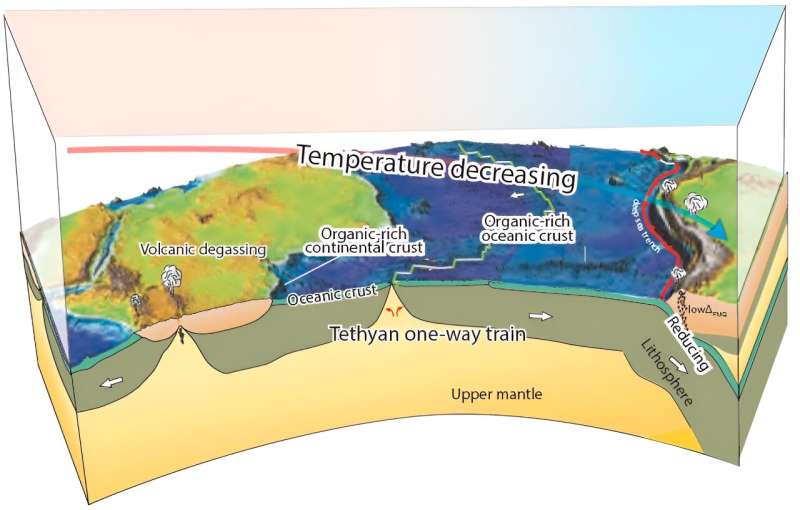This article has been reviewed according to Science X's editorial process and policies. Editors have highlighted the following attributes while ensuring the content's credibility:
fact-checked
peer-reviewed publication
trusted source
proofread
Evidence that ancient Tethys Ocean influenced Earth's past environments

A recent study, published in Science China Earth Sciences and led by geologist Bo Wan from the Chinese Academy of Sciences' Institute of Geology and Geophysics, connects the Tethyan plate tectonic movements to changes in Earth's surface environment. The work reveals Earth's multi-sphere interactions.
The story begins with the Tethyan tectonic evolution, represented by the opening and closure of the succession of the Proto-, Paleo-, and Neo-Tethys oceans.
These three oceans' opening and closing allowed continental fragments of Gondwana to drift northward one after the other. Such latitudinal movement of continents will change the sea-land distribution in the warm and humid tropical region. How Earth's surface environments respond to such sea-land changes in the tropics is still poorly known, according to the authors.
First, the authors found a temporal linkage between significant increases in the continental area at low latitudes and global surface cooling effects during the past 500 million years. The authors then went beyond temporal connections to causal linkages between the two surprisingly connected phenomena.
Bo Wan explained, "Low-latitude regions receive more solar energy influx on Earth's surface than high-latitude areas. Therefore, an increase of landmass in low-latitude regions attenuates the net energy absorption by the Earth's surface, consequently impeding the conduction and convection of absorbed energy toward the poles. The eventual result is a decrease in global surface temperature."
Following such logic, the authors used subduction-driven plate tectonics in the Tethys realm to explain significant ice ages over the past few hundreds of millions of years.
Second, the authors also found that surface environmental changes can affect the mineral resources in the Tethyan realm.
The tropical regions are ideal for the flourishing of marine plankton species and, therefore, the generation of organic-rich sediment. Massive biological debris is, therefore, deposited on continental margins when a continent drifts across the tropics. This creates favorable conditions for subsequent hydrocarbon and reservoir formation.
Moreover, northward subduction of organic-rich sediments during the closure of the Tethyan oceans could result in the generation of mafic arc magmas with low oxygen fugacity. This chemical environment helps the mineralization of reduced-type ore deposits such as tungsten, tin, and lithium.
In sum, subduction-driven plate tectonics in the Tethys realm changes the distribution of oceans and landmass, subsequently affecting the balance and distribution of solar energy across the Earth's surface. These changes trigger consequential environmental shifts, which, in turn, impact the composition of rocks and minerals along the Eurasian margin due to subduction. Altogether, the Tethyan realm and its history is an ideal natural laboratory for comprehending the processes and changes of the entire Earth's system.
More information: Bo Wan et al, The influence of Tethyan evolution on changes of the Earth's past environment, Science China Earth Sciences (2023). DOI: 10.1007/s11430-023-1185-3
Journal information: Science China Earth Sciences
Provided by Science China Press




















